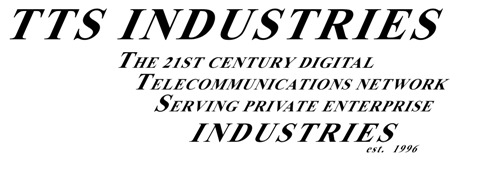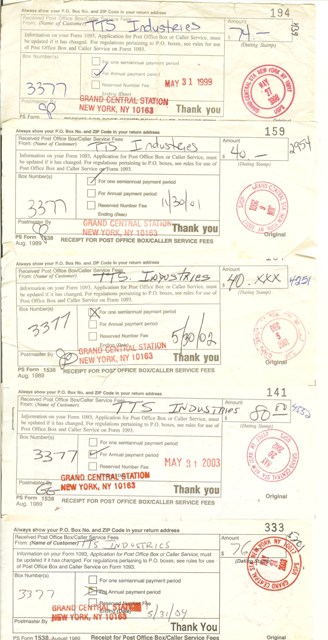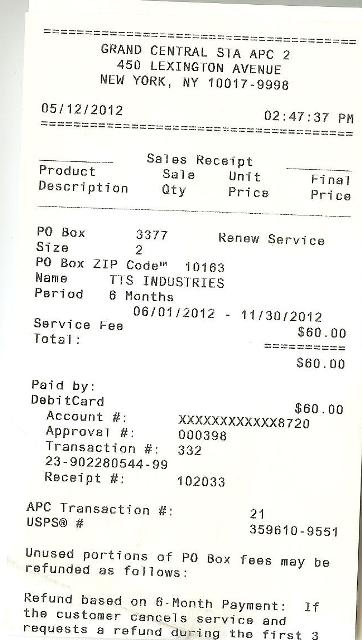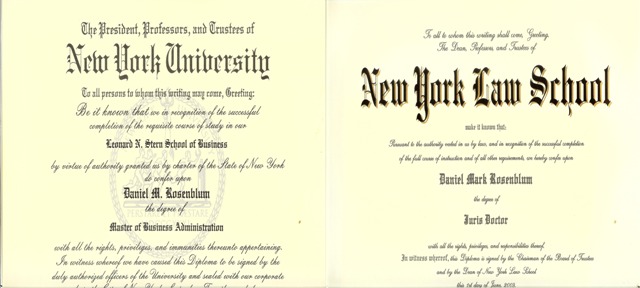

Below, a history of the mark and 21st Century Digital initiative as told with a focus on May 20th 1996 Business Certificate for TTS Industries...
This webpage was compiled and originally published in May of 2012, the 16th Anniversary of the establishment of the 21st Century Digital business initiative. Moving through the first quarter of 2014, this page is occasionally updated to include additional materials which are incorporated into the narrative below.
Please note that since 2006 we have marketed a variety of products separate from our flagship product including laptops, MP3 players, and other devices and accessories for listening, recording, working, watching, sending, receiving, and playing with digital media. Please contact sales at sales@21stcenturydigital.us for inquiries. Please allow up to 4 to 6 weeks time; inquiries regarding other 21st Century Digital services marketed since 1996 can also be sent to that address, or contact Dan Rosenblum as per 21st Century Digital media on this website/past contact info.
Below, a history of the mark and 21st Century Digital initiative...



"..... A 21st Century Digital Network is a consumer driven internet technology based digital commercial network defined by specific licensing agreements between the network's Manufacturers of Hardware, the Network's Writer of Operating System, the network's Information Carriers, and the network's Administrator. The specific licensing agreements are writ and contracted to by the entities for the purpose and with the goal of maintaining the integrity of property rights in data transferred, processed, or transmitted on said network(s). By patenting the method/network design structure, a lynchpin for proprietary consumer driven digital commercial networks is created, unlike any utilized to date....."
"....The TTS CLA's (Contractual Licensing Agreements) are anchored by/for/in 1) United States Governance, 2) any applicable patents, and 3) market considerations for the purpose of maintaining integrity of trademark and copyright processed, transmitted, or otherwise transferred on network. This, whilst serving business/consumer rights, needs, supply, and demand. Each/any individual network is owned by network administrators, carriers, manufacturers, writers, contract holders, contract providers and users pertaining thereto as agreed. In this manner proprietary rights are associated with national consumer driven commercial digital networks in accordance with us governance. Commerce between networks is likewise governed in accordance with the CLA's as anchored by/for/in 1) United States governance, 2) any applicable patents, and 3) market considerations.”
"...The use of items Trademarked and/or Copyrighted in the United States of America for commercial purposes is subject to United States Federal Trade Commission, US Department of Justice, US Department of the Treasury, US Federal Reserve, US Securities and Exchange Commission, and other Federal, State, and Municipal governance, be it Executive, Legislative, or Judicial in nature as is provided by law. "





1. My patent application lists two articles I wrote which discuss the applied for invention "21st Century Digital Network" for the USPTO 37 CFR ¶ 1.105 Information Requirement. NON-PATENT LITERATURE DOCUMENTS
The applicant provides an Information Disclosure
Statement (IDS) at the earliest possible stage of
prosecution detailing the most pertinent
references known to applicant. The Examiner is
to consider each reference cited in the IDS prior
to the next Office action on the merits.


2011 Patent Application Response to Non-Final Rejection
2011 Trademark Registration in USPTO Classes 35, 36, & 38
2011 Patent Application Response to Non-Final Rejection
My official USPTO patent application was in process starting mid-2006 with my provisional application for a 21st Century Digital Network. Originally, in 1996, I had hope to go public with an IPO President's Week 1998, and to write a patent application for 21st Century Digital Network prior to IPO. Given the Grand Larceny allegations made by Citibank, I was unable. During January 2011, USPTO Patent Attorney Carrie Stroder issued a non-final rejection on the 21st Century Digital Network Patent Application. My response to the non-final rejection had a six month statute of limitations for response, which I finalized in July 2011. I refer to my response filed July 2011 with the USPTO as "TTS 7/11 USPTO". My response addresses the USPTO argument for non-registration of the patent, which term would run through 2023. :
2011 Trademark Registration in USPTO Classes 35, 36, & 38
During 2011 the mark 21st Century Digital registered in 3 more classes applied for during 2006. The mark registered on one certificate during August 2011 in USPTO International Class 35: Advertising and Business. Three months later the mark 21st Century Digital registered in two more classes on one certificate: USPTO International Class 36: Financial Services and USPTO International Class 38: Telecommunications.
USPTO Registration Aug. 9, 2011 USPTO International Class 35: Advertising and Business
USPTO Registration Nov. 8, 2011 USPTO International Class 36: Financial Services
USPTO Registration Nov. 8, 2011 USPTO International Class 38: Telecommunications
NOTE: There are multiple stories which document and convey the history of, my commercial use of, and my agenda for my 21st Century Digital® Trademark; One such history is the story of my college education and advanced degree education. While the current Section of this webpage is concerned with Fall of 1998, which includes a discussion of my brief attendance at Brooklyn Law School, here is a link to another webpage dedicated to telling the '21st Century Digital' Agenda & Trademark Story through Dan Rosenblum's education in college, law school, and business school, in particular through my law school and business school application essays, which in turn describe how my undergraduate education contributed to my professional degrees and 21st Century Digital: http://www.twentyfirstcenturydigital.com/EducationalEssays21stCenturyDigitalDescription.php
In 1998 the felony Grand Larceny charges against me (resultant the Citibank Branch Manager's perjury) were still in the Manhattan Criminal Court system. Those charges were dismissed April 5, 1999.
During 1997 and 1998 I, Dan Rosenblum, contended that a Citibank official perjured causing a Felony Grand Larceny allegation handed down from the NY DA's office. To further complicate matters, in the Criminal Court Grand Larceny proceedings which ensued an unauthorized legal defense was facilitated by an unauthorized attorney in my name. The concocted legal defense was a fabrication by the attorney without my knowledge and against my expressed legal instructions. I was strongly of the opinion that the Citibank branch manager perjured when stating to the NYPD and NY District Attorney that I did not have permission to possess the monies I withdrew at the Citibank branch at 48th and 3rd Avenue. The allegation of Grand Larceny resulted from reliance by NYPD on the Citibank Branch Manager's perjurious statement.
During 1997 and 1998 (and in the years that followed as well) my remarks on this subject made to regulatory agencies seemed to fall into an abyss or a black hole. There was little more I could do than to try to substantiate and memorialize my opinion and remarks by making official regulatory filings regarding the subject with the hopes that eventually the wheels of justice would hoist the derailed train back onto the tracks.
Also during 1998 I applied to and was accepted at Brooklyn Law School. As summer was coming to a close and the academic year 1998-1999 was about to begin September 1998 Traveler's Group and Citibank proposed a merger be approved by the Federal Reserve Board to create Citigroup. As summer was coming to a close I was also trying to achieve financing for Brooklyn Law School. To substantiate and memorialize my opinion and remarks regarding the effect of the Citibank Felony Grand Larceny allegation on my business initiative 21st Century Digital and my personal life, I wrote a comment letter for deliberation by the Board in contemplation of approving or denying the merger to create Citigroup. I completed the comment letter during Labor Day weekend of 1998.
There were aspects of my financial profile which were severely effected by the Larceny Charges by Citibank, which adversely effected my ability to borrow educational loans to finance law school. In the aftermath of the whirlwind in my life surrounding the Felony charges, I was being told by doctors that I should not work (described in greater detail below). I was counting on my educational loans cover my living expenses as summer turned to Autumn 1998. I was unable to achieve financing for Brooklyn Law School. During the same few days surrounding Labor Day Weekend 1998 I was 'Involunarily withdrawn for failure to meet tuition obligation' from Brooklyn Law School about 10 business days after matriculation. The link above which contains my Labor Day 1998 Letter to the Federal Reserve Board also contains an image of letter from Brooklyn Law and the educational law school loan denial from Student Loan Corporation, a subsidiary of Citibank. The Felony Grand Larceny Charges alleged by Citibank were made 12/6/1996, and were subsequently dismissed in entirety April 5, 1999. During the April 5th 1999 court proceedings I filed my 9/8/1998 Labor Day Letter to the Federal Reserve Board with New York State Supreme Court as the Felony charges were dismissed. Later that day and April 6th, related materials were filed with the NY State Departmental Disciplinary Committee, NY Federal Reserve, the Office of the Comptroller of the Currency NY Office, and the Social Security Administration, as the image in the link above to my Labor Day 1998 Lettter to the Federal Reserve Board demonstrates.


However, complications abounded while the charges were levied against me prior to dismissal of the charges 12/1996 to 4/1999. Very significantly, I disapproved of significant maneuvers brought into play in that legal mess by the attorney hired to defend me against the Grand Larceny allegation. I was steadfast in my assertion that the Citibank Branch Manager perjured in statements to NYPD. However, unbeknownst to me, the attorney set in motion an unauthorized legal defense. My attempts to rectify the situation were not successful, and related complications rendered me unable to finance my legal education at Brooklyn Law School in 1998. I was unable to renew my Manhattan residence lease and rendered homeless November 1 1998.
During 1997 and 1998 I tried to bring the unauthorized legal defense to the attention of the appropriate authorities. Because I believed that attorney Steven K Frankel of the law firm Frankel, Rudder and Lowery in Manhattan, New York, behaved in an unethical or dishonest manner, I filed a complaint with the Departmental Disciplinary Committee,
Supreme Court, Appellate Division,
First Judicial Department in New York.
From 1999 through 2005 while living without domicile in New York State, I necessarily had interaction with law enforcement, given my domicile every night was on public property on New York State municipal land in Suffolk and Manhattan Counties. Specifically, I was cited by municipal law enforcement ian Manhattan, Southampton, and East Hampton New York for camping without a permit or being in a park while it was closed approximately 5 times per year 1999-2005, with each docket requiring multiple court appearances in front of Judges in East Hampton, Southampton, and Manhattan. Thus, I appeared in front of a judge in NY approximately 20 or 20 times per year from 1999-2005 to answer why I was without domicile at that time. At this link I have posted a sampling of transcripts and Certificates of Disposition, and summonses from that time period:

When I lived without domicile from 1999 through 2005 I slept outside virtually every night for some 1500 + nights. In East Hampton I camped on the beach at Wiborg Beach. In Southampton at Old Town Beach, and in Manhattan on Port Authority of New York and New Jersey Pier 34. Also, probably 50 nights in Central Park, Jacob Riis, near the GW Bridge, on the East River East of Alphabet City, and a good part of the winter of 1999-2000 on Fire Island near Atlantique, Seaview, and Sunken Forest. I'd say a good estimate of 1200 nights in EH, SH, and PANYNJ. I maintained storage in EH, SH and NY and gym memberships at Bally's and EH gym. Privileges at Omni Health and Raquetball. At first, in 1999, showered only in Central Park at the Tennis Courts. Summer of 2000 only bathed in the ocean in EH. For shelter, only a tarp through 2002 (?). Purchased tent. Bought bicycle. Tight budget. {insert images of maps of wiborg, old town, and PANYNJ on linked page}. To be certain, law enforcement issued summonses regularly. {also insert link to NY Times article}. It was necessary to answer such summonses, or, in other words, defend my actions. That is, I had to defend myself for sleeping. In my defense, I wrote, over time, TTS Title I and II, and then TTS Title X, which were filed through pleas and informations in each of 3 jurisdictions Manhattan, Southampton, and East Hampton between 1999 and 2005. I limited access to legal materials and word processing resources, so the process was slow going. As the NY Times article points out, I was meticulously clean where I camped, never leaving any foodstuff or debris. In fact, for fear of theft, I rarely carried my cookware with me where I slept- rather, I locked it in storage and then retrieved it to cook the next day- stowing my shelter gear and retrieving my cookware, then returning the cookware to storage and retrieving my toiletries and making my way to the gym to shower, etc. Hot summers and cold winters made these chores difficult, but necessary. As I was able I went to libraries to write my legal defense, and as I was able I applied for work. I cooked oats virtually every day, and sometimes eggs and pasta. In the early years of this process, I got water from Fire Departments in NYC, or filled water in Central Park.
{separate the pleas from the dispos} {page link to Title I and Title II}
Note that when I applied to law school in 2005, it was necessary for me to submit a "Character and Fitness" disclosure to all law schools to which I applied answering the following question:
"Have you ever, either as an adult or a juvenile, been cited, arrested, taken into custody, charged with, indicted, convicted or tried for, or pleaded guilty to, the commission of any felony or misdemeanor or the violation of any law, except for minor traffic violations, or been the subject of juvenile delinquency or youthful offender proceeding, or is any such action pending or expected to be brought against you?"
Here is a copy of my response, my "Character and Fitness Disclosure" for my admission to law school:


Significantly, in the 6 month period prior to Citibank's allegation of Felony Grand Larceny, I had applied to Citibank for a loan for 21st Century Digital. That is, I established TTS Industries May 20th of 1996 as displayed above. That same week I submitted an original TTS Industries Business Certificate to Frank Turk of Citicorp as part of my loan application in his office at the Citicorp Corporate Headquarters at 399 Park Avenue in New York, New York. Significantly, during 1996 I had reservations regarding the extent to which the business agenda of 21st Century Digital was in direct conflict with a burgeoning business agenda set forth by Citicorp and the major US Banks during the mid 1990s. Specifically, I grew concerned that no major US bank would invest in the 21st Century Digital agenda of processing trademarked and copyrighted materials because such agenda could eventually compete directly with the burgeoning market of processing financial data- which every US bank was interested in doing in the mid 1990s. However, it seemed plain and simple to me that by design banks and financial institutions were regulated such as not to be engaged in commercial enterprise other than lending. Eventually my research established that there are two doctrines and relatedregulations which are in place to prohibit financial institutions from engaging in commerical enterprise other than lending: the Antitying Doctrine and the Permissible Activities Doctrine. During 1997 through 2005 my expertise in the areas of Antitying and Permissible Activities for Bank/Financial Holding Companies was slow to develop given the matters alluded to above and below. After 2006, while I was in law school, I wrote papers on both topics: Permissible Activities for Bank Holding Companies and Section 106 of the Bank Holding Company Act of 1970. At root, the purpose of the two doctrines is to promote competition, innovation, and growth in an economy. Essentially, the business of banking is limited to loans, discounts, deposits and trusts.Earnings for banks should be derived from those four activites. In theory, if bank earnings are derived from commercial activities other than loans, discounts, deposits, and trusts then there will be a disincentive for banks to lend in the industry where banks are deriving earnings from the additional commercial activity the bank is engaged in. This is because in most industries the bank earns only interest on the capital it lends in any given industry. However, if banks are participating directly in a market and are deriving earnings in such market which exceeds the interest rate it could earn by lending in the industry, then, it is counterintuitive for the bank to lend in such industry. From my perspective in 1996, this was exactly the case when it came to secure processing of digital data. Furthermore, while Bank Holding Companies in 1996 were permitted to process financial data, BHCs were prohibited from processing non-financial data. But this limitation would not protect the secure non-financial data processing industry, rather, it would stymy the secure non-financial data processing market. The Commerical Internet was still very much a product of the future. It would be almost a decade until Google and then some till Facebook. In any event, during June, July, August, and September of 1996 I continued to get "the runaround" from Citicorp, and the I felt that such runaround was indicative of this phenomena regarding Permissible Activities and the AntiTying Doctrine for BHCs given BHC participation in the financial data processing industry and the technology behind digital data processing. Therefore, as a safeguard, in October of 1996 I filed a complaint with the Office of the Comptroller of the Currency [insert link}. I elaborate and document subject matter related to the October 1996 OCC Complaint in my July 2013 webpage.
By October and November of 1996 I had little to no capital. My Citibank bank statements from October, November and December 1996 illustrate this. I did nothing to make it appear as if I had money in my bank account during that time period, and I simply relied on the fact that Citibank could and would process financial data associated with my bank account accurately. It seemed to me that Citibank was in the business of processing financial data associated with my bank account, and that there would be some kind of warranty associated with the provision of that service that I could rely on the bank to process my checks accurately. Especially over a four day period, and especially for a not insignificant amount of monies.

2011
Article on Durbin amendment
This webpage was compiled and originally published in May of 2012, the 16th Anniversary of the establishment of the 21st Century Digital business initiative. Moving through the first quarter of 2014, this page is occasionally updated to include additional materials which are incorporated into the narrative below. Specificallly, one major addition to this webpage since 2012 is a new page published in July 2013 , and another addition during Autumn 2013 are my webpages associated with my litigation in American Express v Daniel Rosenblum, my Document list and Filing Recepits for the 21 Items filed 9/15/2013 by Daniel M. Rosenblum in NY State Supreme Court Index # 061458/2013 American Express FSB v Rosenblum.
During 1st quarter 2014, in addition to an additional 40 hours 'day job' driving a truck delivering glass shower doors, I am litigating the American Express matter, and, it is necessary as well to devote some attention to a trademark application made by Neil Young pertaining to my mark 21st Century Digital™.....

21st Century Digital ™ is both a common law and statutory trademark. Common law rights in the Mark inhere with the establishment of Sole Proprietorship Twenty First Century Digital by Proprietor Daniel M Rosenblum December 9th 1996 New York New York and continued use to date. Please see above and below for more information on common law trademark use and rights.
21st Century Digital® has four (4) USPTO Trademark Registrations:
USPTO ®™ Registration Number 4,007,885 Registered Aug. 9, 2011 USPTO International Class 35: Advertising and Business
USPTO ®™ Registration Number 4,051,315 Registered Nov. 8, 2011 USPTO International Class 36: Financial Services
USPTO ®™ Registration Number 4,051,315 Registered Nov. 8, 2011 USPTO International Class 38: Telecommunications
USPTO ®™ Registration Number 3,626,967 Registered May 26, 2009 USPTO International Class 42: Computer/Internet R & D
A patent application for a "21st Century Digital™ Network" was filed with the United States Patent and Trademark Office on March 26, 2008 and published on October 1, 2009 by the United States Patent and Trademark Office as Publication Number US 2009/0248536 Al; USPTO Publication US 2009/0248536 Al is five (5) pages in entirety including the drawing of the invention and can be viewed on the USPTO website Patent Application Retrieval (PAIR) system. No patent for a "21st Century Digital Network" product granted to date, nor is one pending. The status of the patent application at the United States Patent and Trademark Office is "abandoned" as of March 23rd, 2012, for applicant failure to respond to a USPTO Office Action Notice of Final Rejection September 9 2011. Applicant's most recent filing on USPTO patent application for a "21st Century Digital™ Network", USPTO Publication Number US 2009/0248536 Al, one hundred and fifty two pages regarding the 21st Century Digital Network product was filed July 2011 and is also viewable on the USPTO website Patent Application Retrieval (PAIR) system.